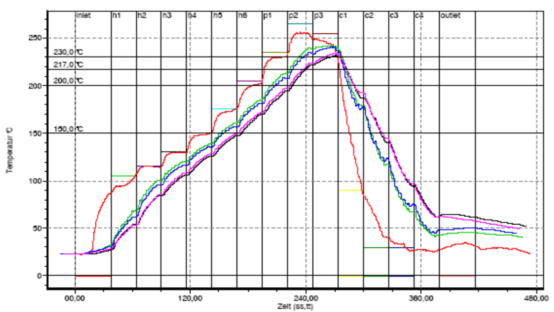Requirements and influencing factors of reflow soldering process flow
Release time:2024-05-15Publisher:Jeenoce
Reflow soldering is necessary in SMT production process. The advantage of reflow soldering is that the temperature is easy to control, oxidation can be avoided during the welding process, and manufacturing costs are also easier to control. There is a heating circuit inside the reflow soldering machine, which heats the gas to a sufficiently high temperature and blows it towards the circuit board where the components have already been attached, allowing the solder on both sides of the components to melt and bond with the motherboard. The quality of SMT products is directly determined by the quality of reflow soldering technology. JEENOCE would like to introduce the process flow, requirements, and influencing factors of reflow soldering. Convenient for everyone to more accurately grasp the reflow soldering process.
1、 The reflow soldering process involves surface mounted boards, which are complex and can be divided into two types: single-sided mounting and double-sided mounting.
A. Single sided mounting: pre coated solder paste → mounting (divided into manual mounting and machine automatic mounting) → reflow soldering → inspection and electrical testing.
B. Double sided mounting: A-side pre coated solder paste → SMT (divided into manual mounting and machine automatic mounting) → Reflow soldering → B-side pre coated solder paste → SMT (divided into manual mounting and machine automatic mounting) → Reflow soldering → Inspection and electrical testing.
The simplest process of reflow soldering is "screen printing solder paste patch reflow soldering". The core is the accuracy of screen printing, and the yield of the patch is determined by the PPM of the machine. Reflow soldering controls the temperature rise, maximum temperature, and temperature drop curves.

2、 Reflow soldering process requirements
1. Reasonable reflow soldering temperature curve should be set and real-time temperature curve testing should be conducted regularly.
2. Welding should be carried out according to the welding direction specified in the PCB design.
3. Strictly prevent vibration of the conveyor belt during the welding process.
4. It is necessary to inspect the welding effect of the first printed circuit board.
5. Whether the welding is sufficient, whether the surface of the solder joint is smooth, whether the shape of the solder joint is half moon shaped, the situation of solder balls and residues, and the situation of continuous welding and virtual welding. Also, check for color changes on the surface of the PCB. Adjust the temperature curve based on the inspection results. During the entire production process, welding quality should be regularly checked.
3、 Factors affecting reflow soldering process
Usually, PLCC and QFP have a larger heat capacity compared to a discrete sheet metal component, making it more difficult to weld large-area components than small ones.
2. In the reflow soldering furnace, the conveyor belt not only performs reflow soldering on the conveyed products, but also becomes a heat dissipation system. In addition, the heat dissipation conditions at the edges and centers of the heating part are different, and the temperature at the edges is generally lower. In addition to different temperature requirements in each temperature zone, the temperature on the same load surface also varies in the furnace.
3. The impact of different product loading capacities. The adjustment of the temperature curve for reflow soldering should consider achieving good repeatability under no-load, load, and different load factors. The load factor is defined as: LF=L/(L+S); Where L=length of assembled substrate, S=spacing of assembled substrate. The greater the load factor, the more difficult it is to achieve good repeatability in reflow soldering process. The maximum load factor of a reflow soldering furnace typically ranges from 0.5 to 0.9. This depends on the product situation (component welding density, different substrates) and the different models of the reflow furnace. To achieve good welding results and repeatability, practical experience is crucial.

